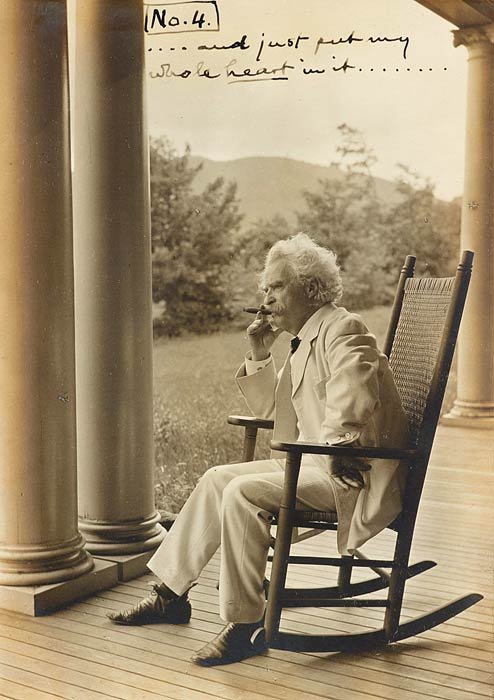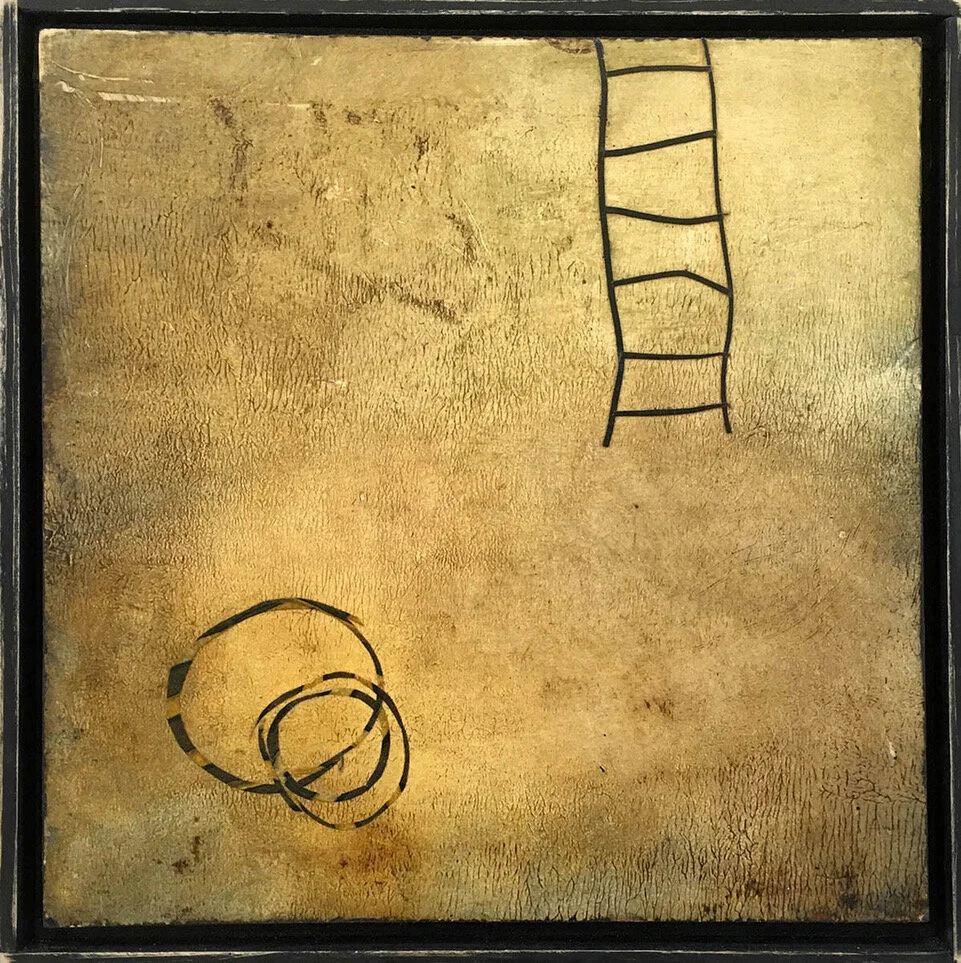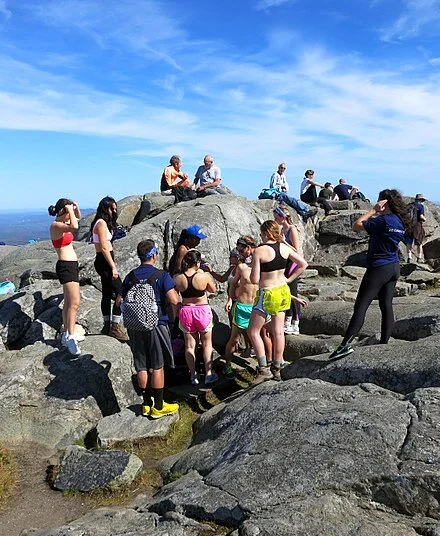
The ‘courage’ of a flea?
Mark Twain in Dublin, N.H., where he summered in 1905 and 1905. He loved that area.
He wrote: “Courage is resistance to fear, mastery of fear-not absence of fear. Except a creature be part coward it is not a compliment to say it is brave; it is merely a loose misapplication of the word. Consider the flea!-Incomparably the bravest of all the creatures of God, if ignorance of fear were courage. Whether you are asleep or awake he will attack you, caring nothing for the fact that in bulk and strength you are to him as are the massed armies of the earth to a sucking child; he lives both day and night and all days and nights in the very lap of peril and the immediate presence of death, and yet is no more afraid than is the man who walks the streets of a city that was threatened by an earthquake ten centuries before. When we speak of Clive, Nelson, and Putnam as men who ‘didn't know what fear was,’ we ought always to add the flea-and put him at the head of the procession.”
The light is always changing
The common of Lyme, N.H.
— Photo by Magicpiano
“Downtown’’ Dublin, N.H., the highest town in New England and the headquarters of Yankee Inc., which owns Yankee Magazine.
“I have lived in New Hampshire nearly forty years, and I am still discovering places and moments of beauty that surprise me. Sometimes it may be seeing the same setting — a country road, a hillside, a meadow — in a different light or in a different season.’’
— Mel Allen, editor of Yankee Magazine
Art and civics in Peterboro
“Hidden Myth” (collagraph, wax, tape), by Soosen Dunholter, a Peterboro, N.H.-based painter.
Peterboro, in New Hampshire’s (Mount) Monadnock Region (named for the mountain that has long been reputed to be the second-most climbed in the world, after Mt. Fuji), is famous for the many writers and other artists who have lived and/or worked there. That’s party because of the MacDowell Colony, which has been a cozy and supportive place for writers, composers and visual artists to work since its founding, in 1907. One of its writers was Thornton Wilder, who is said to have based the community, Grover’s Corners, in his famous play Our Town on Peterboro. Peterboro is still more rural than not, but Boston’s exurban sprawl is pushing toward the town, which remains a weekend and vacation home for quite a few affluent people.
Peterboro is well known for its engaged and well-informed citizenry.
Next door is beautiful Dublin, the highest town in New England and the site of the headquarters of Yankee Inc., which publishes the eponymous magazine and the Old Farmer’s Almanack and has a couple of glorious lakes. For many years Dublin hosted Beech Hill Farm, a substance-abuse (mostly of alcohol) facility in an old mansion on top of Beech Hill that drew a fair share of celebrities who needed to dry out. The property is no longer used for that.
Children’s arts parade in Peterboro.
Bond House at the MacDowell Colony
The top of Mount Monadnock on a typically crowded day in warm weather.
William Morgan: Treasures from the 50-cent photo bin
The best part of any New England antique shop, for my money, is the old photos. In some higher-end boutiques the postcards and pictures can be $5 apiece or more. But I struck pay dirt in Bowerbird & Friends, in Peterborough, N.H., which has scores of snapshots for 50¢ each. I bought five mysterious images.
The majority of those in the photo basket are 3 ½ -inch-square prints from the trusty Brownie box cameras of the 1950s.
There is a certain pathos in all these discarded records from a pre-digital age. While, far too few of these have any notation who and where the people are, this octet of friends is identified as "Picnic at Lillian Bliss Summer house in Otis" (Massachusetts, presumably), dated most accurately by the loafers and bobby sox.
Almost as typical is the earlier 20th-Century group photo posed before a church. The picture is 4 by 2 ½ inches.
The faded color of this mystery photo would seem to be earlier than the Nov. 73 date stamped on the back. At first, this appeared to be a man with a still, but on closer inspection the plastic jugs seem to hold apple cider. How New England, how autumnal.
Even odder is the 2 ½-by-4 ½ inch carte de visite of Dr. Chas. C. Peck, the coroner of McHenry County, Ill., from the summer of 1910. Or perhaps it is a political handout, as our lugubrious-looking Dr. Peck is a candidate for Supreme Medical Examiner, Mystic Workers of the World. Despite its dark title, the Workers were a Midwestern fraternal organization that sold insurance to its members. Their medical examiners presumably decided on whom should be underwritten and who was too much of a risk, or in Peck's case, if they were still among the living.
Strangest of the quintet of Peterborough oddities is this photograph of wedding guests from Aug. 3, 1963, in an era when most women still wore hats to such events, not to mention pearls. The picture was taken by Robert English, probably the state senator from nearby Hancock, N.H. (whose district included Peterborough and Dublin). The ceremony was perhaps taken at the tony Dublin Lake Club, where the senator's daughter was married three years later. Just an amateur shot, perhaps, but English has really captured a slice-of-life social commentary: the moneyed Republican couple, the grand dame, and frumpy and awkward daughter.
William Morgan, a Providence-based essayist and architectural historian, has taught the history of photography at Princeton University and is the author of Monadnock Summer: The Architectural Legacy of Dublin, New Hampshire.
In Dublin: Art, astronomy, Yankee Inc., peace confabs, Twain, etc.
“Close Call’’ (assemblage), by Robert Hauser, in his current show at the Putnam Gallery at the Dublin School, Dublin. N.H.
The gallery says that Mr. Hauser is an artist and conservator “who works in assemblage and the Gestalt Theory. In this show, he explores the history of developments and discoveries in astronomy. Each work is based on a single concept and reflects his engagement with ideas, cultural responses and personal connections to knowledge. Each piece is not a statement but an opportunity for association and development of a narrative by the viewer with both the work and the ideas that inspired it.’’
Dublin, long a weekend and vacation refuge for wealthy Bostonians, New Yorkers and Philadelphians, is also known as the highest town in New England; headquarters of Yankee Inc. which publishes The Old Farmer’s Almanac and Yankee magazine; an estate, with a mansion, called Beech Hill Farm that later became a famous “drying out spa’’ for alcoholics (some of them celebrities) and is now a private estate again, and the two Dublin Peace Conferences, held at the Morse Farm in 1945 and 1965, out of which grew the United World Federalists.
Not usually bustling downtown Dublin
Mark Twain spent two summers in Dublin, and pronounced it his favorite place in the world. Here he is at Dublin’s Mountain View Farm, which he rented in 1906.
Something to look forward to
"Redbud Tree in Bottomload,'' photo by ELIOT PORTER, at the Portland Museum of Art (but photo is copyrighted by Amon Carter Museum of American Art, Forth Worth) in the Portland Museum's show "American Vision: Photographs from the Collection of Owen and Anna Wells''.
Please comment via rwhitcomb51@gmail.com
Jan. 7, 2014
Cold morning today but far from the "polar vortex'' catastrophe that it's being made out to be by the news media because their denizens think that nothing much else is going on. Of course, lots of stuff is going on but it bores those reporters and editors who haven't yet been laid off in the ferment caused by the triumph of mostly ''free'' information on the Internet. And maybe the public doesn't care all that much either.
Most importantly, "polar vortex'' sounds like a horror-movie monster. Very sexy. More vortexes to come because global warming is screwing up the jet stream? Too early to say with scientific assurance.
It's all rather typical of January, the coldest month. But February is often the snowiest because warm wet air begins to edge north again, setting up conflict with the cold air. Great for creating Nor'easters! Arctic air and the Gulf Stream can be in explosive proximity.
As I walked the dog this morning I enjoyed the crunch of my feet on the thin layer of snow that had fallen overnight as the front swung through from Canada, bringing a snow squall or two. And the frozen trees were creaking. Too cold to be slippery! The problem in the coastal Northeast is the wind. It can make urban walking miserable. When I lived in the Upper Connecticut River Valley, the temperature could be much colder than in Boston, Providence, New York and Philadelphia but the comfort level much higher because there was much less wind and it was very, very dry. Sort of exhilarating -- bright and almost antiseptically clean.
Meanwhile, along the lines of ever-more "nurturing'' of children by parents and schools (at the ones I attended we were often called by our last names and there wasn't much open concern for our feelings), is the practice of clothing our dogs for winter walks, even outside of the Upper East Side of Manhattan. I must confess that my wife and I have adopted this habit. The dog, a rescue mutt from San Antonio (via "Alamo Rescue''), fought having a coat on at the start but has since accepted it -- especially when it's windy.
My most physically painful memories of winter are in the streets of big cities with the northwest wind squeezing between the high buildings.
When it's really, really cold, ice is so sticky that you don't even worry about driving up and down steep snow-covered hills. A few times I had to drive my drunken mother to a drying-up spa at a place called Beech Hill Farm, on top of a mountain in Dublin, N.H. -- the little town where Yankee magazine was, and is, put out and where Mark Twain spent some happy times. If it was the winter, I'd pray for very cold weather. Around freezing was the most insidious, with a thin layer of melting in the sun, then quick refreezing toward evening.
The dramatic freeze-thaw cycles in New England make skiing more, well, exciting here than on the dusty, dry "powder snow'' promoted by resorts in the Rockies. Skiing in the White and Green mountains is much more of a challenge to muscles and nerves than is skiing at, say, Taos.
Anyway, I long for late February, when sun-facing cars and rooms suddenly seem to start to warm up much faster as the sun gets stronger. Even on a very cold day last week, I found the stone on a southwest-facing wall remarkably warm. We really do need to do a lot more with passive solar heating.
















